2006 HONDA ODYSSEY Dipstick
[x] Cancel search: DipstickPage 288 of 420

Wait a f ew minutes af ter turning the
engine of f bef ore you check the oil.Remove the dipstick again, and
check the level. It should be
between the upper and lower
marks.
To close the hood, lif t it up slightly to
remove the support rod f rom the
hole. Put the support rod back into
its holding clip. Lower the hood to
about a f oot (30 cm) above the
f ender, then let it drop. Make sure it
is securely latched. Remove the dipstick (orange loop).
Wipe of f the dipstick with a clean
cloth or paper towel.
Insert it all the way back in its hole.
Pull the support rod out of its clip
and insert the end into the hole on
thepassenger’ssideof thehood.
If it is near or below the lower mark,
seeon page .
1.
3.
2.
3.4.
334
Oil Check
A dding Engine Oil
Service Station Procedures
Bef ore Driving
287
DIPSTICK
SUPPORT ROD
UPPER MARK
LOWER MARK
Page 334 of 420
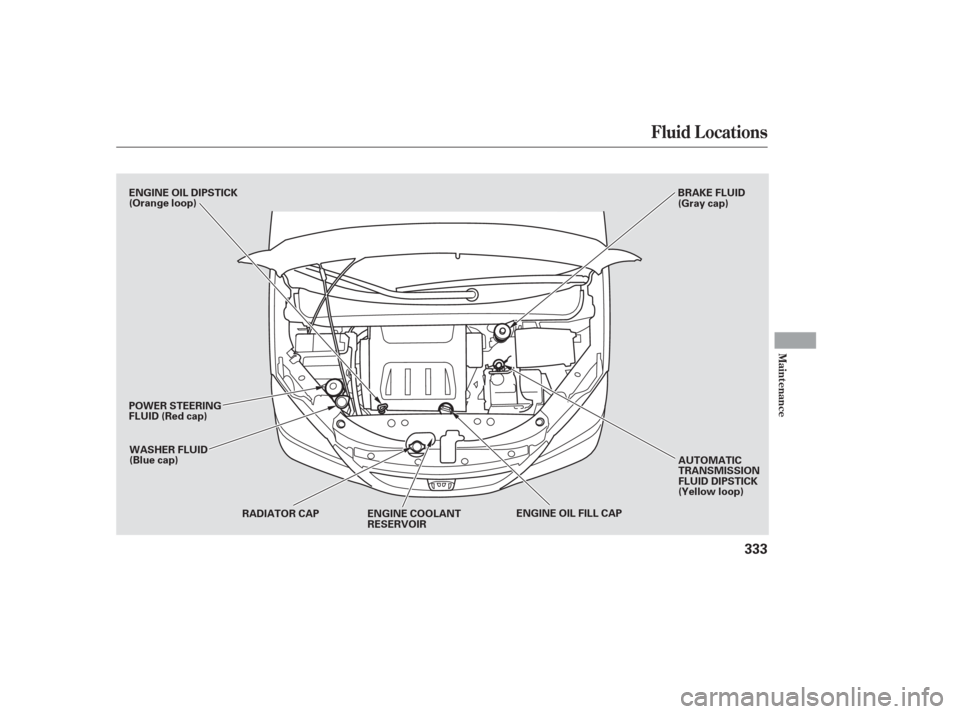
Fluid Locations
Maint enance
333
ENGINE OIL DIPSTICK
(Orange loop)WASHER FLUID
(Blue cap)
POWER STEERING
FLUID (Red cap)
RADIATOR CAP ENGINE OIL FILL CAPAUTOMATIC
TRANSMISSION
FLUID DIPSTICK
(Yellow loop)
BRAKE FLUID
(Gray cap)
ENGINE COOLANT
RESERVOIR
Page 337 of 420
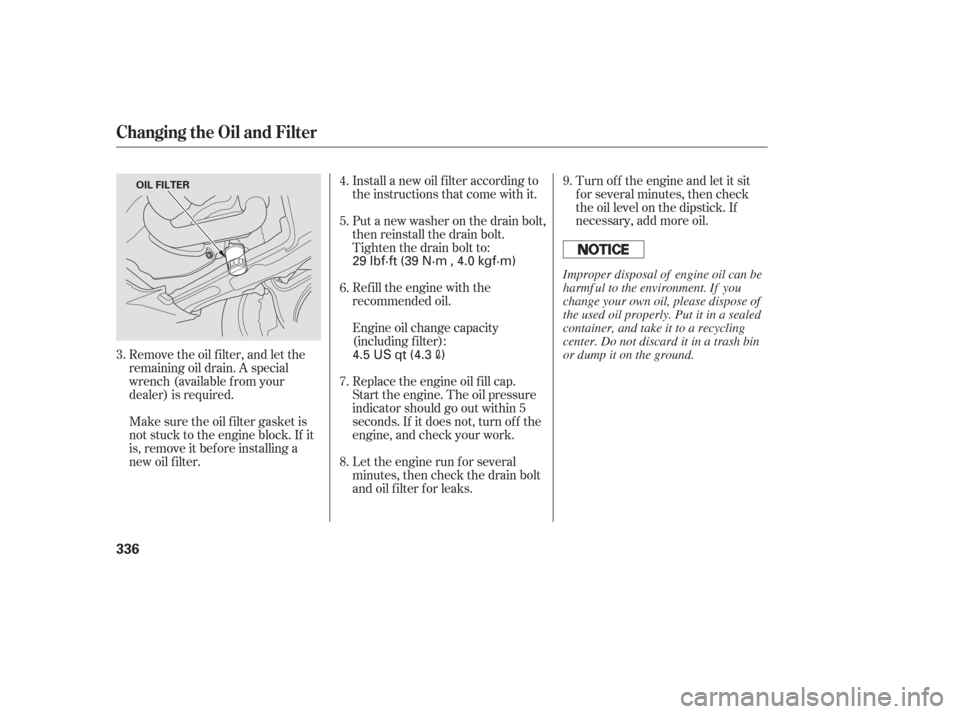
Remove the oil f ilter, and let the
remaining oil drain. A special
wrench (available from your
dealer) is required.Turn of f the engine and let it sit
f or several minutes, then check
the oil level on the dipstick. If
necessary, add more oil.
Let the engine run f or several
minutes, then check the drain bolt
and oil f ilter f or leaks. Replace the engine oil f ill cap.
Start the engine. The oil pressure
indicator should go out within 5
seconds. If it does not, turn of f the
engine, and check your work. Engine oil change capacity
(including f ilter): Refill the engine with the
recommended oil. Install a new oil f ilter according to
the instructions that come with it.
Put a new washer on the drain bolt,
then reinstall the drain bolt.
Tighten the drain bolt to:
Make sure the oil f ilter gasket is
not stuck to the engine block. If it
is, remove it bef ore installing a
new oil f ilter. 9.
8. 7. 6. 4.
5.
3.
Changing the Oil and Filter
336
OIL FILTER
4.5 US qt (4.3)
29 lbf·ft (39 N·m , 4.0 kgf·m)
Improper disposal of engine oil can be
harmf ul to the environment. If you
change your own oil, please dispose of
the used oil properly. Put it in a sealed
container, and take it to a recycling
center. Do not discard it in a trash bin
or dump it on the ground.
Page 341 of 420
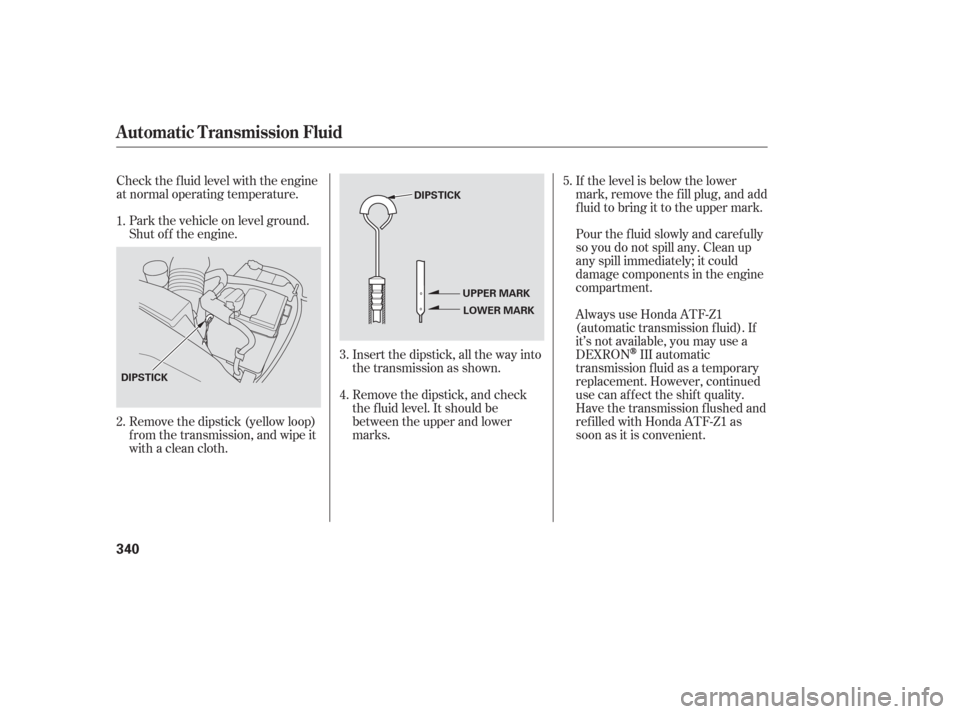
Pour the f luid slowly and caref ully
so you do not spill any. Clean up
any spill immediately; it could
damage components in the engine
compartment.
Always use Honda ATF-Z1
(automatic transmission f luid). If
it’s not available, you may use a
DEXRON
III automatic
transmission f luid as a temporary
replacement. However, continued
use can af f ect the shif t quality.
Have the transmission flushed and
ref illed with Honda ATF-Z1 as
soon as it is convenient.
Check the f luid level with the engine
at normal operating temperature.
Park the vehicle on level ground.
Shut of f the engine.
Remove the dipstick (yellow loop)
f rom the transmission, and wipe it
with a clean cloth. Insert the dipstick, all the way into
the transmission as shown.If the level is below the lower
mark, remove the f ill plug, and add
f luid to bring it to the upper mark.
Remove the dipstick, and check
the f luid level. It should be
between the upper and lower
marks. 5.
3.
4.
1.
2.
Automatic Transmission Fluid
340
DIPSTICK
UPPER MARKLOWER MARK
DIPSTICK
Page 342 of 420
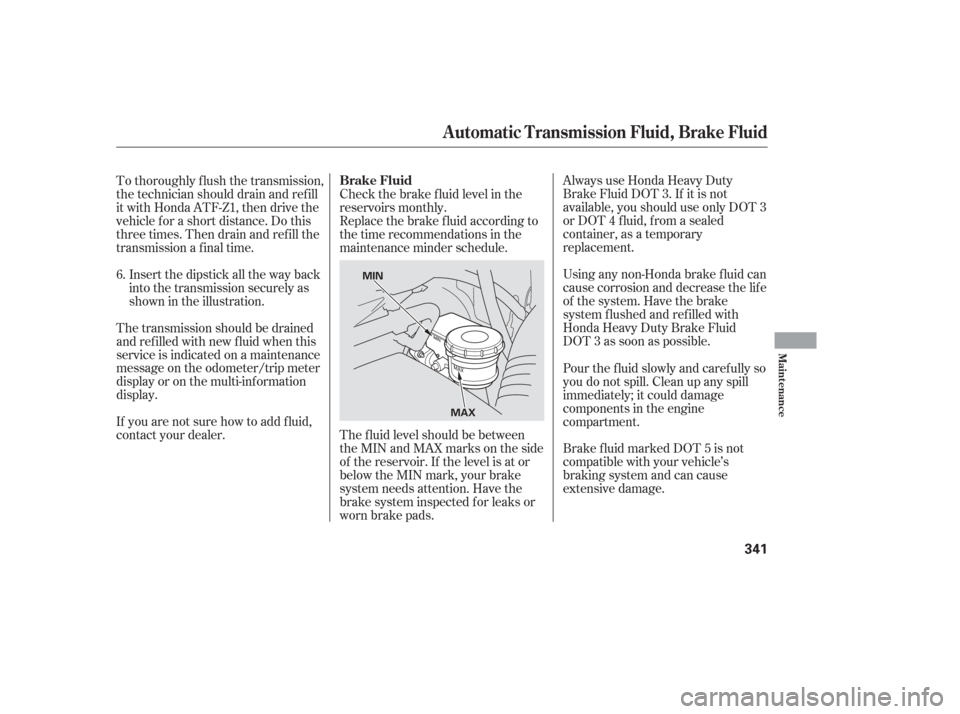
Always use Honda Heavy Duty
Brake Fluid DOT 3. If it is not
available, you should use only DOT 3
or DOT 4 f luid, f rom a sealed
container, as a temporary
replacement.
Using any non-Honda brake f luid can
cause corrosion and decrease the lif e
of the system. Have the brake
system f lushed and ref illed with
Honda Heavy Duty Brake Fluid
DOT 3 as soon as possible.
Brake f luid marked DOT 5 is not
compatible with your vehicle’s
braking system and can cause
extensive damage.
Check the brake f luid level in the
reservoirs monthly.
The f luid level should be between
theMINandMAXmarksontheside
of the reservoir. If the level is at or
below the MIN mark, your brake
system needs attention. Have the
brake system inspected f or leaks or
worn brake pads.
To thoroughly f lush the transmission,
the technician should drain and ref ill
it with Honda ATF-Z1, then drive the
vehicle f or a short distance. Do this
three times. Then drain and ref ill the
transmission a f inal time.
Insert the dipstick all the way back
into the transmission securely as
shown in the illustration.
The transmission should be drained
and ref illed with new f luid when this
service is indicated on a maintenance
message on the odometer/trip meter
display or on the multi-inf ormation
display.
If you are not sure how to add f luid,
contact your dealer. Replace the brake f luid according to
thetimerecommendationsinthe
maintenance minder schedule.
Pour the f luid slowly and caref ully so
you do not spill. Clean up any spill
immediately; it could damage
components in the engine
compartment.
6.
Automatic Transmission Fluid, Brake Fluid
Brake Fluid
Maint enance
341
MAX
MIN
Page 378 of 420
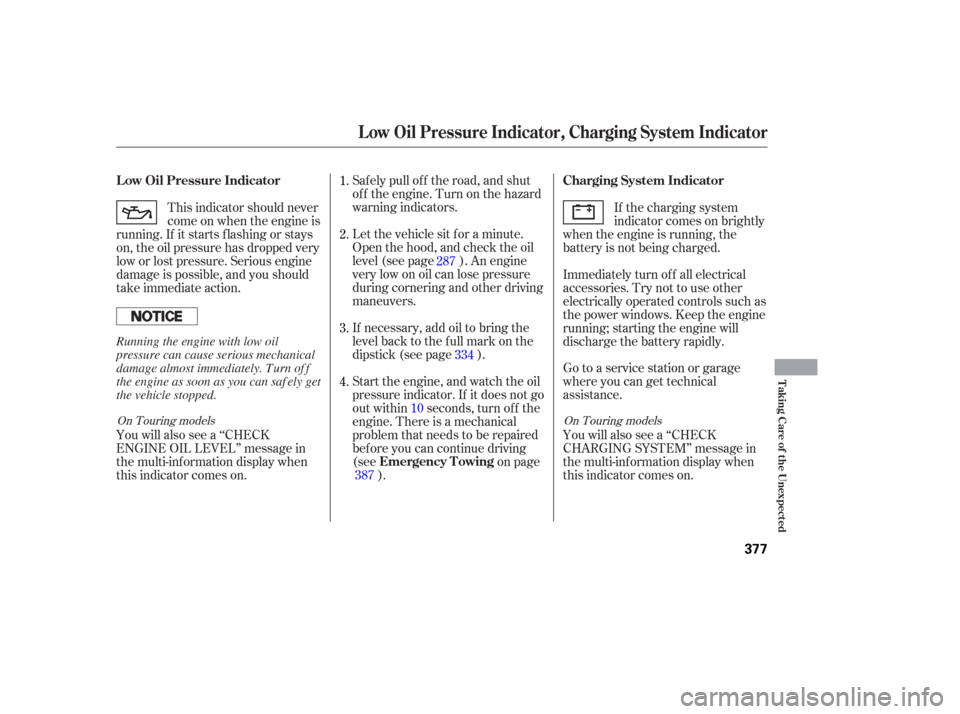
Saf ely pull of f the road, and shut
of f the engine. Turn on the hazard
warning indicators.
Let the vehicle sit f or a minute.
Open the hood, and check the oil
level (see page ). An engine
very low on oil can lose pressure
during cornering and other driving
maneuvers.
If necessary, add oil to bring the
level back to the full mark on the
dipstick (see page ).
Start the engine, and watch the oil
pressure indicator. If it does not go
out within10seconds, turn of f the
engine. There is a mechanical
problem that needs to be repaired
bef ore you can continue driving
(see on page
).
You will also see a ‘‘CHECK
ENGINE OIL LEVEL’’ message in
the multi-information display when
this indicator comes on. This indicator should never
come on when the engine is
running. If it starts f lashing or stays
on, the oil pressure has dropped very
low or lost pressure. Serious engine
damage is possible, and you should
take immediate action.
You will also see a ‘‘CHECK
CHARGING SYSTEM’’ message in
the multi-information display when
this indicator comes on. Go to a service station or garage
where you can get technical
assistance. Immediately turn of f all electrical
accessories. Try not to use other
electrically operated controls such as
the power windows. Keep the engine
running; starting the engine will
discharge the battery rapidly.If the charging system
indicator comes on brightly
when the engine is running, the
battery is not being charged.
1.
2.
3.
4. 287
334
387
On Touring models On Touring models
L ow Oil Pressure Indicator
Emergency T owingCharging System Indicator
L ow Oil Pressure Indicator, Charging System Indicator
T aking Care of t he Unexpect ed
377
Running the engine with low oil
pressure can cause serious mechanical
damage almost immediately. Turn of f
the engine as soon as you can saf ely get
the vehicle stopped.
Page 412 of 420
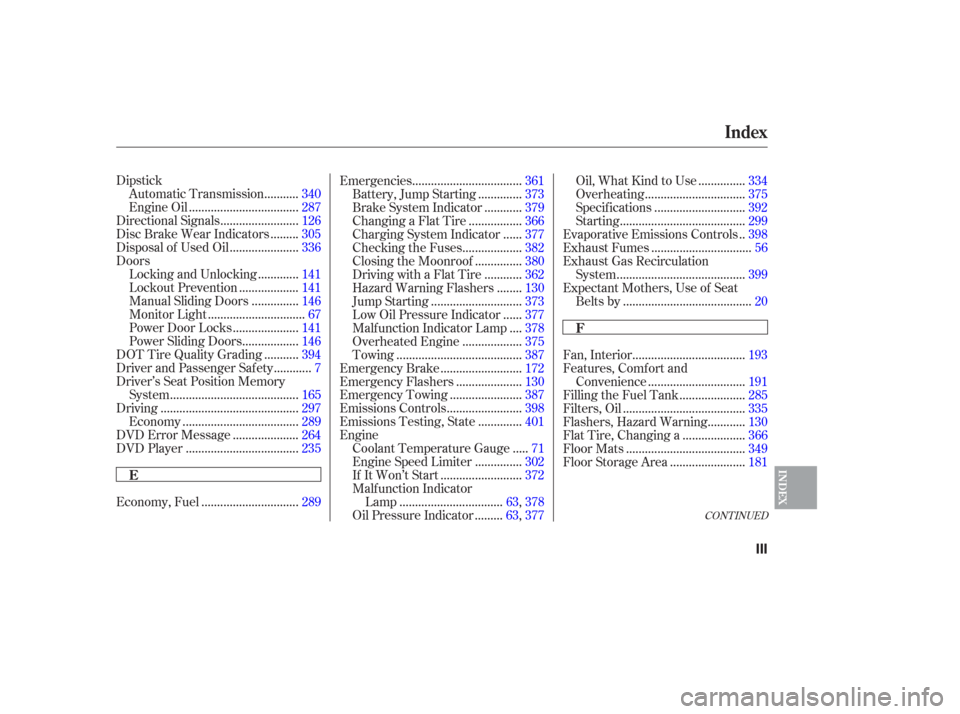
CONT INUED
Dipstick..........
Automatic Transmission .340
..................................
Engine Oil .287
........................
Directional Signals .126
........
Disc Brake Wear Indicators .305
.....................
Disposal of Used Oil .336
Doors ............
Locking and Unlocking .141
..................
Lockout Prevention .141
..............
Manual Sliding Doors .146
..............................
Monitor Light .67
....................
Power Door Locks .141
.................
Power Sliding Doors .146
..........
DOT Tire Quality Grading .394
...........
Driver and Passenger Safety .7
Driver’s Seat Position Memory
........................................
System .165
...........................................
Driving .297
....................................
Economy .289
....................
DVD Error Message .264
...................................
DVD Player .235
..............................
Economy, Fuel .289 ..................................
Emergencies .361
.............
Battery, Jump Starting . 373
...........
Brake System Indicator . 379
................
Changing a Flat Tire . 366
.....
Charging System Indicator . 377
..................
Checking the Fuses . 382
..............
Closing the Moonroof . 380
...........
Driving with a Flat Tire . 362
.......
Hazard Warning Flashers . 130
............................
Jump Starting .373
.....
Low Oil Pressure Indicator . 377
...
Malf unction Indicator Lamp . 378
..................
Overheated Engine . 375
.......................................
Towing .387
.........................
Emergency Brake .172
....................
Emergency Flashers .130
......................
Emergency Towing .387
.......................
Emissions Controls .398
.............
Emissions Testing, State . 401
Engine ....
Coolant Temperature Gauge . 71
..............
Engine Speed Limiter . 302
.........................
If It Won’t Start .372
Malf unction Indicator ................................
Lamp .63, 378
........
Oil Pressure Indicator . 63,377 ..............
Oil, What Kind to Use . 334
...............................
Overheating .375
............................
Specif ications .392
.......................................
Starting .299
.
Evaporative Emissions Controls . 398
...............................
Exhaust Fumes .56
Exhaust Gas Recirculation ........................................
System .399
Expectant Mothers, Use of Seat ........................................
Belts by .20
...................................
Fan, Interior .193
Features, Comfort and ..............................
Convenience .191
....................
Filling the Fuel Tank . 285
......................................
Filters, Oil .335
...........
Flashers, Hazard Warning . 130
...................
Flat Tire, Changing a . 366
.....................................
Floor Mats .349
.......................
Floor Storage Area .181
Index
E FINDEX
III